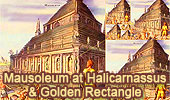 The Golden Rectangle and the Mausoleum at Halicarnassus The Golden Rectangle and the Mausoleum at Halicarnassus
Successive Golden Rectangles dividing a Golden Rectangle into squares
(the Mausoleum at Halicarnassus, hand-coloured engraving by Martin Heemskerck, 1498-1574).
Mausolus' great tomb,
Built in ancient times of old,
Legacy endures.
A golden rectangle
is a rectangle whose side lengths are in the golden ratio, one-to-phi, that is, approximately 1:1.618.
A distinctive feature of this shape is that when a square section is removed, the remainder is another golden rectangle, that is, with the same proportions as the first. Square removal can be repeated infinitely, which leads to an approximation of the golden
or Fibonacci spiral.
Fibonacci numbers
(0,1,1,2,3,5,8,13,21,34...) are a sequence of numbers named after Leonardo of Pisa, known as Fibonacci.
The first number of the sequence is 0, the second number is 1, and each subsequent number is equal to
the sum of the previous two numbers of the sequence itself.
The Tomb of Mausolus, Mausoleum of Mausolus or Mausoleum at Halicarnassus, was a tomb built between 353 and 350 BC at Halicarnassus (present Bodrum, Turkey) for Mausolus, a satrap in the Persian Empire, and Artemisia II of Caria, his wife and sister.
The structure was designed by the Greek architects Satyrus and Pythius. It stood approximately 45
meters (135 ft) in height, and each of the four sides was adorned with sculptural reliefs created by each one of four Greek sculptors — Leochares, Bryaxis, Scopas of Paros and Timotheus. The finished structure was considered to be such an aesthetic triumph that Antipater of Sidon identified it as one of his Seven Wonders of the Ancient World.

|